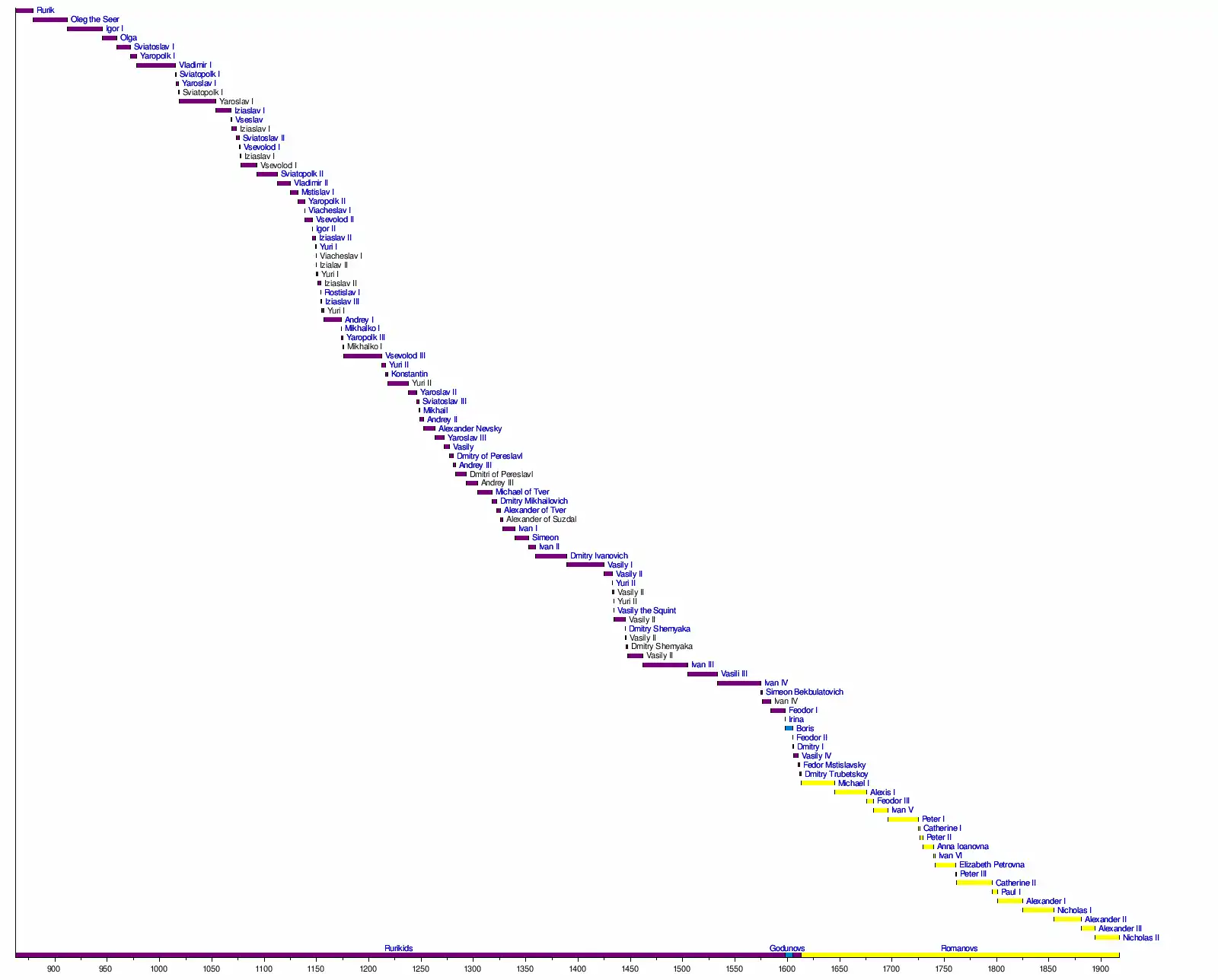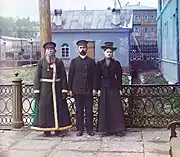List of leaders of Russia
This is the list of rulers of Ancient Rus', the Russian Tsardom, Empire, Republic, the RSFSR, the USSR, and the modern Russian Federation. It does not include regents, acting rulers, rulers of the separatist states in the territory of Russia, persons who applied for the post of ruler, but did not join it, rebel leaders who do not control the capital and the nominal heads of the RSFSR from the formation of the USSR to the establishment of the presidency of Russia.
 |
|---|
| This article is part of a series on the politics and government of the Russian Federation |
|
|
Princes of Ancient Rus' (862–1547)
Princes of Novgorod (862–882)
- Rurik (862 — 879)
- Oleg the Seer (879 — 882)
Grand Princes of Kiev (882–1157)
- Oleg the Seer (882 — fall 912)
- Igor I (912 — fall 945)
- Olga of Kiev (fall 945 — after 959)
- Sviatoslav I (after 959 — March 972)
- Yaropolk I (972 — June 11, 978)
- Vladimir the Great (June 11, 978 — July 15, 1015)
- Sviatopolk the Cursed (July 1015 — Fall 1016)
- Yaroslav the Wise (fall 1016 — july 22, 1018)
- Sviatopolk the Cursed (August 14, 1018 — 1019)
- Yaroslav the Wise (1019 — February 20, 1054)
- Iziaslav I (February 1054 — September 15, 1068)
- Vseslav the Sorcerer (September 15, 1068 — April 1069)
- Iziaslav I (May 2, 1069 — March 1073)
- Sviatoslav II (March 22, 1073 — December 27, 1076)
- Vsevolod I (January 1, 1077 — July 1077)
- Iziaslav I (July 15, 1077 — October 3, 1078)
- Vsevolod I (October 1078 — April 13, 1093)
- Sviatopolk II (April 24, 1093 — April 16, 1113)
- Vladimir Monomakh (April 20, 1113 — May 19, 1125)
- Mstislav I (May 20, 1125 — April 15, 1132)
- Yaropolk II (April 17, 1132 — February 18, 1139)
- Viacheslav I (February 22 — March 4, 1139)
- Vsevolod II (March 5, 1139 — August 1, 1146)
- Igor II (August 2 — 13, 1146)
- Iziaslav II (August 13, 1146 — after August 23, 1149)
- Yuri the Long Hands (August 28, 1149 — August 1150)
- Viacheslav I (August 1150)
- Iziaslav II (August 1150)
- Yuri the Long Hands (August 1150 — early 1151)
- Iziaslav II (March 1151 — November 13, 1154)
- Rostislav I (December 1154)
- Iziaslav III (December 1154 — March 1155)
- Yuri the Long Hands (March 20, 1155 — May 15, 1157)
Grand Princes of Vladimir (1157–1340)
- Andrey the Pious (June 4, 1157 — June 29, 1174)
- Mikhalko I (1174)
- Yaropolk III (September 1174 — June 15, 1175)
- Mikhalko I (June 15, 1175 — June 20, 1176)
- Vsevolod the Big Nest (June 1176 — April 15, 1212)
- Yuri II (April 1212 — April 27, 1216)
- Konstantin of Rostov (April 1216 — February 2, 1218)
- Yuri II (February 1218 — March 4, 1238)
- Yaroslav II (1238 — September 30, 1246)
- Sviatoslav III (1246 — early 1248)
- Mikhail Khorobrit (early 1248 — winter 1248/1249)
- Andrey II (December 1249 — July 24, 1252)
- Alexander Nevsky (1252 — November 14, 1263)
- Yaroslav of Tver (1264 — 1272)
- Vasily of Costroma (1272 — January 1277)
- Dmitry of Pereslavl (1277 — 1281)
- Andrey of Gorodets (1281 — 1283)
- Dmitry of Pereslavl (December 1283-1293)
- Andrey of Gorodets (1293 — July 27, 1304)
- Michael of Tver (autumn 1304 — November 22, 1318)
- Dmitry the Fearsome Eyes (1318 — November 2, 1322)
- Alexander of Tver (1322 — September 15, 1326)
- Alexander of Susdal (1326 — 1328)
- Ivan Kalita (1331 — March 31, 1340)
Grand Princes of Moscow (1325–1547)
- Ivan I Kalita (November 21, 1325 — March 31, 1340)
- Simeon the Proud (March 31, 1340 — April 26, 1353)
- Ivan II the Red (April 26, 1353 — November 13, 1359)
- Dmitry of the Don (13 November 1359 — 19 May 1389)
- Vasily I (May 19, 1389 — February 27, 1425)
- Vasily II the Dark (February 27, 1425 — April 25, 1433)
- Yury of Zvenigorod (spring — summer 1433)
- Vasily II the Dark (summer 1433 — March 31, 1434)
- Yury of Zvenigorod (March 31 — June 5, 1434)
- Vasily the Squint (June 5 — July 1434)
- Vasily II the Dark (July 1434 — July 7, 1445)
- Dmitry Shemyaka (July 7 - October 26, 1445)
- Vasily II the Dark (October 26, 1445 — February 13, 1446)
- Dmitry Shemyaka (February 12, 1446 — February 17, 1447)
- Vasily II the Dark (February 17, 1447 — March 27, 1462)
- Ivan III the Great (March 27, 1462 — October 27, 1505)
- Vasili III (October 27, 1505 — December 4, 1533)
- Ivan IV the Terrible (December 4, 1533 — January 16, 1547)
Tsars of Russia (1547–1721)
Rurikids (1547–1598)
- Ivan IV the Terrible (January 16, 1547 — March 18, 1584)
- Simeon Bekbulatovich (no later than October 30, 1575 — no earlier than July 18, 1576)[1]
- Feodor I (March 19, 1584 — January 7, 1598)
Godunovs (1598–1605)
- Irina Godunova (January 7 — January 15, 1598)
- Boris Godunov (February 17, 1598 — April 13, 1605)
- Feodor II (April 13 — June 1, 1605)
Time of Troubles (1605–1613)
- False Dmitriy I (June 20, 1605 — May 17, 1606)
- Vasili IV Shuysky (May 19, 1606 — July 17, 1610)
- Seven Boyars[2]
- Fedor Mstislavsky (July 17, 1610 — October 22, 1612)
- Zemsky government[3]
- Dmitry Trubetskoy (fall 1612 – spring 1613)
Romanovs (1613–1721)
- Michael Romanov (February 21, 1613 — July 13, 1645)
- Alexis I (July 13, 1645 — January 29, 1676)
- Feodor III (January 30, 1676 — April 27, 1682)
- Ivan V (April 27, 1682 — January 29, 1696)[4]
- Peter I the Great (April 27, 1682 — October 22, 1721)[5]
Emperors of Russia (1721–1917)
- Peter I the Great (October 22, 1721 — January 28, 1725)
- Catherine I (January 28, 1725 — May 6, 1727)
- Peter II (May 6, 1727 — January 19, 1730)
- Anna Ioannovna (February 4, 1730 — October 17, 1740)
- Ivan VI (October 17, 1740 — November 25, 1741)
- Elizabeth Petrovna (November 25, 1741 — December 25, 1761)
- Peter III (December 25, 1761 — June 28, 1762)
- Catherine II the Great (June 28, 1762 — November 6, 1796)
- Paul I (November 6, 1796 — March 11, 1801)
- Alexander I (March 12, 1801 — November 19, 1825)
- Nicholas I (November 19, actually from December 13, 1825 — February 18, 1855)[6]
- Alexander II (February 18, 1855 — March 1, 1881)
- Alexander III (March 1, 1881 — October 20, 1894)
- Nicholas II (October 20, 1894 — March 2, 1917)[7]
Chairmen of the Provisional Government (1917)
- Georgy Lvov (March 2 (15) — July 8 (21), 1917)
- Alexander Kerensky (July 8 (21) — October 25 (November 7), 1917)
Leaders of Soviet Russia (1917–1991)
De facto
- Vladimir Lenin (October 25 (November 7), 1917 — January 21, 1924)
- Joseph Stalin (January 21, 1924 — March 5, 1953)
- Georgy Malenkov (March 5 — September 7, 1953)
- Nikita Khrushchev (September 7, 1953 — October 14, 1964)
- Leonid Brezhnev (October 14, 1964 — November 10, 1982)
- Yuri Andropov (November 12, 1982 — February 9, 1984)
- Konstantin Chernenko (February 13, 1984 — March 10, 1985)
- Mikhail Gorbachev (March 11, 1985 — December 25, 1991)
De jure[8]
- Lev Kamenev (October 27 (November 9) — November 8 (21), 1917)
- Yakov Sverdlov (November 8 (21), 1917 — March 16, 1919)
- Mikhail Vladimirsky (Acting; March 16 – March 30, 1919)
- Mikhail Kalinin (March 30, 1919 — March 19, 1946)
- Nikolai Shvernik (March 19, 1946 — March 15, 1953)
- Kliment Voroshilov (March 15, 1953 — May 7, 1960)
- Leonid Brezhnev (May 7, 1960 — July 15, 1964)
- Anastas Mikoyan (July 15, 1964 — December 9, 1965)
- Nikolai Podgorny (December 9, 1965 — June 16, 1977)
- Leonid Brezhnev (June 16, 1977 — November 10, 1982)
- Yuri Andropov (June 16, 1983 — February 9, 1984)
- Konstantin Chernenko (April 11, 1984 — March 10, 1985)
- Andrei Gromyko (July 2, 1985 — October 1, 1988)
- Mikhail Gorbachev (October 1, 1988 — December 25, 1991)
Presidents of Russia (1991–present)
- Boris Yeltsin (July 10, 1991 — December 31, 1999)[9]
- Vladimir Putin (December 31, 1999 — May 7, 2008)[10]
- Dmitry Medvedev (May 7, 2008 — May 7, 2012)
- Vladimir Putin (May 7, 2012 — present)
Timeline of monarchs

Timeline of leaders since 1917

See also
Notes and references
- In 1575, Ivan the Terrible declared the Kassim Khan "the Grand Duke of all Russia," but retained influence on the country's politics. In 1576, Ivan the Terrible returned to the throne.
- In the period 1610-1612 after the overthrow of Tsar Vasily Shuisky, power in Moscow belonged to the Boyar Duma, which created an interim government of seven boyars. The government was headed by the main boyar - Fedor Mstislavsky.
- In the fall of 1612, a united rebelion liberated Moscow from Polish interventionists and abolished the Seven Boyars. The new government was headed by Dmitry Trubetskoy, who formally led Russia before the election of Mikhail Romanov as Tsar in 1613.
- Rules together with Peter I.
- Rules together with Ivan V.
- During his lifetime, Alexander I appointed Nicholas as heir, because his elder brother Konstantin abdicated the throne, but only a small number of close associates knew about this, which caused the situation of interregnum and the oath of oath to Konstantin began. In December, Konstantin repeatedly abdicated the throne.
- Abdicated in favor of his younger brother Michael. The next day, Michael refused to become Emperor, saying that the fate of the monarchy should be decided by the Constituent Assembly.
- Legally, the highest officials of the Soviet state were:
1917–1922 — Chairman of the All-Russian Central Executive Committee of the RSFSR;
1922–1938 — Chairman of the Central Executive Committee of the USSR
1938–1989 — Chairman of the Presidium of the Supreme Soviet of the USSR;
1989–1990 — Chairman of the Supreme Council of the USSR;
1990–1991 — President of the USSR.
De facto, all these posts (except for the President of the USSR) did not have such an influence as the Head of Government or the General Secretary of the Party. - President of the RSFSR from July 10 to December 25, 1991.
- Acting President until May 7, 2000.
Literature
- Руководители России, СССР, РФ (862—2004) // Большая российская энциклопедия. Том «Россия». — М., 2004.
- История России. Т. 1. С древнейших времён до второй половины XIX века. Т. 2. История России. Вторая половина XIX—XX вв. Курс лекций / Под ред. проф. Б. В. Личмана. — Екатеринбург: Урал. гос. техн. ун-т. 1995.
- Махновец Л. Е. Великi князi киівськi // Летопись Русский / Под Ипатским списком. — К., 1989.
- Князья крупнейших княжеств (сост. В. А. Кучкин) // Древняя Русь в средневековом мире. — М., 2014.
- Состав руководящих органов ЦК Коммунистической Партии (1919—1990) // Известия ЦК КПСС. — 1990. — № 7.
External links
This article is issued from Wikipedia. The text is licensed under Creative Commons - Attribution - Sharealike. Additional terms may apply for the media files.
